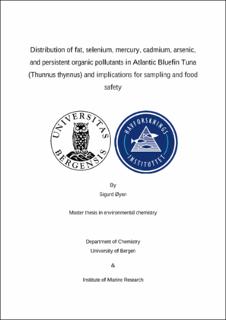| dc.description.abstract | The Atlantic bluefin tuna (ABFT)(Thunnus thynnus) has for a long time been absent off the Norwegian coast, but has started reappearing increasingly in the last decade. The ABFT has both high economic and cultural values, and is a large predatory pelagic fish at the top of the food chain known to accumulate high concentrations of contaminants. Eleven adult and wild ABFT (ranging from 230 to 307 cm straight fork length) caught along the Norwegian coast in the years 2018, 2019 and 2020 were sampled to investigate the content of fat, selenium, mercury, cadmium, arsenic and selected persistent organic pollutants. Ten cuts were sampled from edible tissue of each fish, including fillet, neck, tail, and fat samples. The levels and distributions of the analytes were used to suggest a reasonable and representative sampling procedure in ABFT and to assess food safety. Some samples provided challenges during homogenization. A cryo-mill was successfully used to improve the homogeneity, resulting in visually more homogenous samples and a decrease in the analytical relative standard deviations between parallels. The concentrations and distributions of the investigated substances were mostly following the fat content, with strong negative correlation between fat and mercury (R2=-0.45). The persistent organic pollutants were even stronger positively correlated with fat (R2=0.56). The concentrations of the investigated persistent organic pollutants were high, with PCDD/F ranging from 1.2 ± 1.1 pg/g to 2.9 ± 2.3 pg/g, PCDD/F + dl-PCBs from 8.0 ± 8.4 to 23 ± 15 pg/g and PCB6 from 310 ± 21 to 100 ± 12 ng/g, highlights the importance of the present study. The concentrations of the trace elements ranged from 0.19 ± 0.090 mg/kg to 1.4 ± 0.50 mg/kg, 0.0093 ± 0.0043 mg/kg to 0.042 ± 0.022 mg/kg and 1.3 ± 0.33 mg/kg to 5.3 ± 0.86 mg/kg for mercury, cadmium and arsenic, respectively. A tail sample, cut five, could be shown to be representative for largest part of the fillet of the ABFT with respect to the investigated contaminants. Sampling an aggregate fat sample (cut one), tail sample (cut five) and lean red sample (cut ten) is suggested to investigate the contaminants in ABFT. Mercury and persistent organic pollutants are the two main contaminants limiting the consumption of ABFT muscle/fillet. For the tail sample, an intake of 136 grams and 37 grams would lead to an exceedance of the tolerable weekly intake (TWI) for mercury and PCDD/F + dl-PCBs, respectively. This same sample exceeded the maximum level set for trade in 36% of the fish for mercury and 17% of the fish for PCDD/F +dl-PCBs. However, a large variation in the investigated contaminants between fatty, lean and red muscle was found. | |
